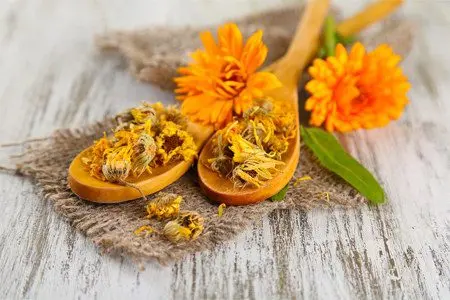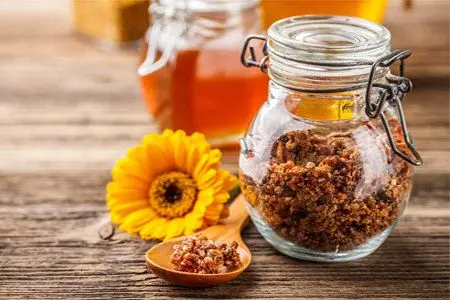Contents

Calendula is a medicinal plant. Calendula blooms with beautiful orange-yellow flowers, and in addition to being used for medicinal purposes, it is also widespread in decorative floriculture. In domestic pharmacology, this plant is very much appreciated.
The flowers of the plant are yellow or orange in color, collected in inflorescences-baskets. The fruit of calendula is an achene, slightly bent, without a tuft. Fruit on the outside of an uneven surface with spines. The flowering of the plant begins in June and ends in September. The fruits ripen in October. The plant is very fond of light, but demanding on moisture and soil. It can be seen in Southern Europe, the Middle East and Western Asia.
For treatment, only inflorescences are used, that is, baskets that are harvested during the flowering period, when the basket has fully blossomed. Leaves and flower stalks are not used. For medicinal purposes, freshly blossomed inflorescences of the plant are harvested.

Medicinal properties of calendula

The scientific medical community recognizes calendula (marigold) as a medicinal plant with a whole range of unique properties. The results of multiple studies suggest that calendula is effective in the treatment of fungal skin lesions, dermatological diseases, diaper rash, wounds of various nature.
Calendula has an anti-inflammatory, analgesic effect, which makes it possible to use it in the treatment of cancer. Experts note that preparations based on it soften the side effects from the use of radiation therapy.
Calendula is used for medicinal purposes as an antiseptic, anti-inflammatory, wound healing agent. It is used for both internal and external use. It has astringent, antispasmodic, choleretic and sedative effects, improves heart function, lowers blood pressure. Quite often, calendula is used to treat diseases of internal organs, the nervous system, as a sedative, as an anticoagulant, immunomodulatory drug. It is also used as a diuretic, diaphoretic, expectorant, analgesic, desensitizing and tonic.
Calendula flowers are also used as an antispasmodic. It is able to relax the smooth muscle structures of such organs as the stomach, intestines and liver, which leads to increased bile formation and bile secretion and increased secretory activity of the stomach.
Among other things, calendula improves regeneration processes. Despite the fact that the bactericidal qualities of calendula are insignificant in relation to streptococci and staphylococci, inflammation processes complicated by bacterial flora, under the influence of preparations from this plant, proceed much easier due to increased growth of granulations, improved epithelialization and strengthening of local defense mechanisms.
Calendula has found the widest application in cosmetology. The active substances of the marigolds have excellent moisturizing and sun protection properties, which helps to preserve the youth and beauty of the skin.
[Video] Here’s what calendula does, the real benefits and harms:
How to store calendula?
Calendula is stored in a dark, dry place to avoid the damaging effects of dampness and ultraviolet light. When buying dried calendula flowers, be sure to pay attention to the expiration date indicated on the package. Herbal raw materials are poured into a plastic container and a glass container with a tight lid.
Home-made products with calendula (oil, cream, tincture) are poured into sealed containers. They can be stored on the refrigerator door.
Possible harm and contraindications of calendula

Calendula is recognized as a safe herb that most people can use, regardless of age. [32].
It is important to remember that external use of calendula can cause an allergic reaction in people with sensitive skin, prone to dermatitis and other allergies. Before use, it is better to perform a sensitivity test – apply a small amount of the product to a small area of u30bu40bthe skin. If after XNUMX-XNUMX minutes there are no negative manifestations (itching, redness, irritation), the product can be used in full. [27].
Negative reactions to calendula can occur in people who are allergic to plants in the Asteraceae family, such as mountain arnica or chamomile. [35].
The pooled results of 46 studies showed that calendula may reduce the effectiveness of sedative and antihypertensive drugs. If you regularly take these drugs, avoid oral use of calendula. [36].
If we are talking about alcohol tincture, then it is contraindicated in acute gastritis, during an exacerbation of peptic ulcer of the stomach and duodenum, with calculous cholecystitis.









